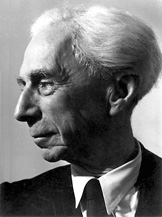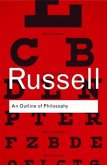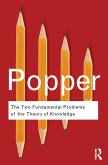Bertrand Russell
The Analysis of Matter
Bertrand Russell
The Analysis of Matter
- Gebundenes Buch
- Merkliste
- Auf die Merkliste
- Bewerten Bewerten
- Teilen
- Produkt teilen
- Produkterinnerung
- Produkterinnerung
The Analysis of Matter is the product of thirty years of thinking by one of the twentieth century's best-known philosophers. This Routledge Classics edition includes the 1992 Introduction by John G. Slater.
Andere Kunden interessierten sich auch für
![The Analysis of Matter The Analysis of Matter]() Bertrand RussellThe Analysis of Matter22,99 €
Bertrand RussellThe Analysis of Matter22,99 €![My Philosophical Development My Philosophical Development]() Bertrand RussellMy Philosophical Development21,99 €
Bertrand RussellMy Philosophical Development21,99 €![Mysticism and Logic Mysticism and Logic]() Bertrand RussellMysticism and Logic16,99 €
Bertrand RussellMysticism and Logic16,99 €![An Outline of Philosophy An Outline of Philosophy]() Bertrand RussellAn Outline of Philosophy16,99 €
Bertrand RussellAn Outline of Philosophy16,99 €![The Two Fundamental Problems of the Theory of Knowledge The Two Fundamental Problems of the Theory of Knowledge]() Karl PopperThe Two Fundamental Problems of the Theory of Knowledge22,99 €
Karl PopperThe Two Fundamental Problems of the Theory of Knowledge22,99 €![The Routledge Companion to Pragmatism The Routledge Companion to Pragmatism]() The Routledge Companion to Pragmatism219,99 €
The Routledge Companion to Pragmatism219,99 €![Human Knowledge Human Knowledge]() Bertrand RussellHuman Knowledge19,99 €
Bertrand RussellHuman Knowledge19,99 €-
-
-
The Analysis of Matter is the product of thirty years of thinking by one of the twentieth century's best-known philosophers. This Routledge Classics edition includes the 1992 Introduction by John G. Slater.
Produktdetails
- Produktdetails
- Routledge Classics
- Verlag: Taylor & Francis Ltd
- Seitenzahl: 402
- Erscheinungstermin: 15. September 2022
- Englisch
- Abmessung: 222mm x 145mm x 25mm
- Gewicht: 604g
- ISBN-13: 9781032312682
- ISBN-10: 1032312688
- Artikelnr.: 64103851
- Herstellerkennzeichnung
- Libri GmbH
- Europaallee 1
- 36244 Bad Hersfeld
- gpsr@libri.de
- Routledge Classics
- Verlag: Taylor & Francis Ltd
- Seitenzahl: 402
- Erscheinungstermin: 15. September 2022
- Englisch
- Abmessung: 222mm x 145mm x 25mm
- Gewicht: 604g
- ISBN-13: 9781032312682
- ISBN-10: 1032312688
- Artikelnr.: 64103851
- Herstellerkennzeichnung
- Libri GmbH
- Europaallee 1
- 36244 Bad Hersfeld
- gpsr@libri.de
Bertrand Russell (1872 - 1970) is regarded as one of the greatest philosophers of the twentieth century and a celebrated writer and commentator on social and political affairs.

Introduction to the Routledge Classics edition John G. Slater Preface 1.
The Nature of the Problem Part 1: The Logical Analysis of Physics 2.
Pre-Relativity Physics 3. Electrons and Protons 4. The Theory of Quanta 5.
The Special Theory of Relativity 6. The General Theory of Relativity 7. The
Method of Tensors 8. Geodesics 9. Invariants and Their Physical
Interpretation 10. Weyl's Theory 11. The Principle of Differential Laws 12.
Measurement 13. Matter and Space 14. The Abstractness of Physics Part 2:
Physics and Perception 15. From Primitive Perception to Common Sense
16. From Common Sense to Physics 17. What is an Empirical Science 18. Our
Knowledge of Particular Matters of Fact 19. Data, Inferences, Hypotheses,
and Theories 20. The Causal Theory of Perception 21. Perception and
Objectivity 22. The Belief in General Laws 23. Substance 24. Importance of
Structure in Scientific Inference 25. Perception From the Standpoint of
Physics 26. Non-Mental Analogues to Perception Part 3: The Structure of the
Physical World 27. Particulars and Events 28. The Construction of Points
29. Space-Time Order 30. Causal Lines 31. Extrinsic Causal Laws 32.
Physical and Perceptual Space-Time 33. Periodicity and Qualitative Series
34. Types of Physical Occurrences 35. Causality and Interval 36. The
Genesis of Space-Time 37. Physics and Neutral Monism 38. Summary and
Conclusion. Index
The Nature of the Problem Part 1: The Logical Analysis of Physics 2.
Pre-Relativity Physics 3. Electrons and Protons 4. The Theory of Quanta 5.
The Special Theory of Relativity 6. The General Theory of Relativity 7. The
Method of Tensors 8. Geodesics 9. Invariants and Their Physical
Interpretation 10. Weyl's Theory 11. The Principle of Differential Laws 12.
Measurement 13. Matter and Space 14. The Abstractness of Physics Part 2:
Physics and Perception 15. From Primitive Perception to Common Sense
16. From Common Sense to Physics 17. What is an Empirical Science 18. Our
Knowledge of Particular Matters of Fact 19. Data, Inferences, Hypotheses,
and Theories 20. The Causal Theory of Perception 21. Perception and
Objectivity 22. The Belief in General Laws 23. Substance 24. Importance of
Structure in Scientific Inference 25. Perception From the Standpoint of
Physics 26. Non-Mental Analogues to Perception Part 3: The Structure of the
Physical World 27. Particulars and Events 28. The Construction of Points
29. Space-Time Order 30. Causal Lines 31. Extrinsic Causal Laws 32.
Physical and Perceptual Space-Time 33. Periodicity and Qualitative Series
34. Types of Physical Occurrences 35. Causality and Interval 36. The
Genesis of Space-Time 37. Physics and Neutral Monism 38. Summary and
Conclusion. Index
Introduction to the Routledge Classics edition John G. Slater Preface 1. The Nature of the Problem Part 1: The Logical Analysis of Physics 2. Pre-Relativity Physics 3. Electrons and Protons 4. The Theory of Quanta 5. The Special Theory of Relativity 6. The General Theory of Relativity 7. The Method of Tensors 8. Geodesics 9. Invariants and Their Physical Interpretation 10. Weyl's Theory 11. The Principle of Differential Laws 12. Measurement 13. Matter and Space 14. The Abstractness of Physics Part 2: Physics and Perception 15. From Primitive Perception to Common Sense 16. From Common Sense to Physics 17. What is an Empirical Science 18. Our Knowledge of Particular Matters of Fact 19. Data, Inferences, Hypotheses, and Theories 20. The Causal Theory of Perception 21. Perception and Objectivity 22. The Belief in General Laws 23. Substance 24. Importance of Structure in Scientific Inference 25. Perception From the Standpoint of Physics 26. Non-Mental Analogues to Perception Part 3: The Structure of the Physical World 27. Particulars and Events 28. The Construction of Points 29. Space-Time Order 30. Causal Lines 31. Extrinsic Causal Laws 32. Physical and Perceptual Space-Time 33. Periodicity and Qualitative Series 34. Types of Physical Occurrences 35. Causality and Interval 36. The Genesis of Space-Time 37. Physics and Neutral Monism 38. Summary and Conclusion. Index
Introduction to the Routledge Classics edition John G. Slater Preface 1.
The Nature of the Problem Part 1: The Logical Analysis of Physics 2.
Pre-Relativity Physics 3. Electrons and Protons 4. The Theory of Quanta 5.
The Special Theory of Relativity 6. The General Theory of Relativity 7. The
Method of Tensors 8. Geodesics 9. Invariants and Their Physical
Interpretation 10. Weyl's Theory 11. The Principle of Differential Laws 12.
Measurement 13. Matter and Space 14. The Abstractness of Physics Part 2:
Physics and Perception 15. From Primitive Perception to Common Sense
16. From Common Sense to Physics 17. What is an Empirical Science 18. Our
Knowledge of Particular Matters of Fact 19. Data, Inferences, Hypotheses,
and Theories 20. The Causal Theory of Perception 21. Perception and
Objectivity 22. The Belief in General Laws 23. Substance 24. Importance of
Structure in Scientific Inference 25. Perception From the Standpoint of
Physics 26. Non-Mental Analogues to Perception Part 3: The Structure of the
Physical World 27. Particulars and Events 28. The Construction of Points
29. Space-Time Order 30. Causal Lines 31. Extrinsic Causal Laws 32.
Physical and Perceptual Space-Time 33. Periodicity and Qualitative Series
34. Types of Physical Occurrences 35. Causality and Interval 36. The
Genesis of Space-Time 37. Physics and Neutral Monism 38. Summary and
Conclusion. Index
The Nature of the Problem Part 1: The Logical Analysis of Physics 2.
Pre-Relativity Physics 3. Electrons and Protons 4. The Theory of Quanta 5.
The Special Theory of Relativity 6. The General Theory of Relativity 7. The
Method of Tensors 8. Geodesics 9. Invariants and Their Physical
Interpretation 10. Weyl's Theory 11. The Principle of Differential Laws 12.
Measurement 13. Matter and Space 14. The Abstractness of Physics Part 2:
Physics and Perception 15. From Primitive Perception to Common Sense
16. From Common Sense to Physics 17. What is an Empirical Science 18. Our
Knowledge of Particular Matters of Fact 19. Data, Inferences, Hypotheses,
and Theories 20. The Causal Theory of Perception 21. Perception and
Objectivity 22. The Belief in General Laws 23. Substance 24. Importance of
Structure in Scientific Inference 25. Perception From the Standpoint of
Physics 26. Non-Mental Analogues to Perception Part 3: The Structure of the
Physical World 27. Particulars and Events 28. The Construction of Points
29. Space-Time Order 30. Causal Lines 31. Extrinsic Causal Laws 32.
Physical and Perceptual Space-Time 33. Periodicity and Qualitative Series
34. Types of Physical Occurrences 35. Causality and Interval 36. The
Genesis of Space-Time 37. Physics and Neutral Monism 38. Summary and
Conclusion. Index
Introduction to the Routledge Classics edition John G. Slater Preface 1. The Nature of the Problem Part 1: The Logical Analysis of Physics 2. Pre-Relativity Physics 3. Electrons and Protons 4. The Theory of Quanta 5. The Special Theory of Relativity 6. The General Theory of Relativity 7. The Method of Tensors 8. Geodesics 9. Invariants and Their Physical Interpretation 10. Weyl's Theory 11. The Principle of Differential Laws 12. Measurement 13. Matter and Space 14. The Abstractness of Physics Part 2: Physics and Perception 15. From Primitive Perception to Common Sense 16. From Common Sense to Physics 17. What is an Empirical Science 18. Our Knowledge of Particular Matters of Fact 19. Data, Inferences, Hypotheses, and Theories 20. The Causal Theory of Perception 21. Perception and Objectivity 22. The Belief in General Laws 23. Substance 24. Importance of Structure in Scientific Inference 25. Perception From the Standpoint of Physics 26. Non-Mental Analogues to Perception Part 3: The Structure of the Physical World 27. Particulars and Events 28. The Construction of Points 29. Space-Time Order 30. Causal Lines 31. Extrinsic Causal Laws 32. Physical and Perceptual Space-Time 33. Periodicity and Qualitative Series 34. Types of Physical Occurrences 35. Causality and Interval 36. The Genesis of Space-Time 37. Physics and Neutral Monism 38. Summary and Conclusion. Index









